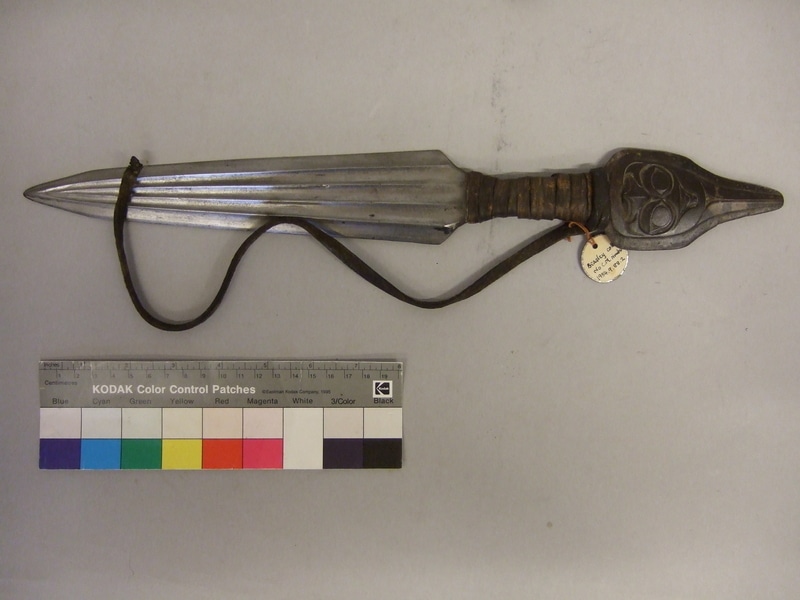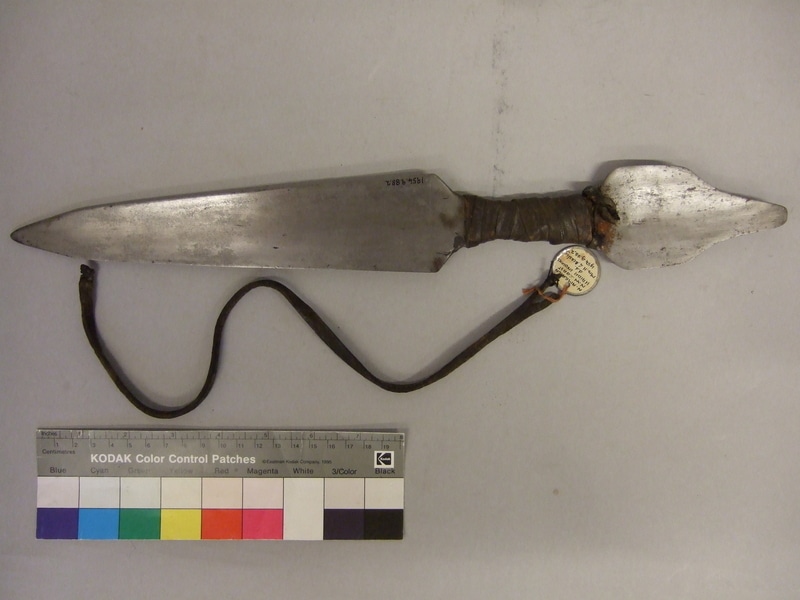Dagger Item Number: 1954.9.88 .2 1954.9.88 .3 from the Pitt Rivers Museum


Description
Dagger with double-edged fluted blade and image of an octopus chiselled on the hilt.
Display History
PRM display label [1974 - 1975] - North Pacific Coast, Haida. Iron dagger with a double-edged, fluted blade. The grip is bound in leather and there is the image of a bird chiselled on the hilt. d.d. Mrs. H.G. Beasley, 1954. [LM 17/04/2007]
Longer Description
Dagger with double-edged fluted blade and image of an octopus chiselled on the hilt. The octopus is depicted with large eyes, beak, with a design on its forehead, and a tall extension on the top of the head. There are small circles with central dots incised on the dagger that represent octopus suckers. The grip is bound with a leather thong. The hilt appears to have been stained to look like copper. [CAK 21/05/2010]
Research Notes
The following information comes from Haida delegates who worked with the museum’s collection in September 2009 as part of the project “Haida Material Culture in British Museums: Generating New Forms of Knowledge”:
This dagger was viewed alongside other daggers on Monday Sept 14, 2009. Delegates had two suggestions for the figure depicted on the dagger. Most often, they identified it as an octopus because of the beak on the face, general appearance, and also because of the small circles with central dot found on this dagger and throughout objects on the collection. The other suggestion given for the figure was an owl. The metal was identified as steal, though it was unclear to delegates if it was cast or engraved. Christian White observed that there is cross-hatching remaining on the back of the blade and wondered if the dagger was made from a large file. Delegates identified its use as ceremonial, where people would dance with the dagger or re-enact fighting. Discussion of Haida daggers more generally can be viewed on Tape 9, time 5:27, which can be found in the Haida Project Related Documents File. [CAK 21/05/2010]
Primary Documentation
Accession Book Entry - 'MRS H. G. BEASLEY, WHITE BARN, SUNNINGDALE, BERKS. Specimens from the Cranmore Museum... 1954.9.88A N. AMERICA, N.W. COAST. HAIDA. Steel dagger, made by Europeans for trade, with characteristic HAIDA design on handle. Grip bound with leather thong looped for carrying. (3). L. 42.7 cm. Imitates HAIDA form and has been stained to look like copper.
There is no further information on the catalogue card. [CW 11 6 98]
Pitt Rivers Museum label - N. AMERICA N.W. COAST HAIDA INDIANS d.d. Mrs. H.G. Beasley 1954.9.88.2 [rev:] Beasley coll. No C.M. number 1954.9.88.2 [LM 17/04/2007]
Pitt Rivers Museum label [on strap .3] - N. AMERICA, CANADA, BRITISH COLUMBIA QUEEN CHARLOTTE Ids HAIDA GWAII Leather strap for dagger. Beasley coll. [LKG 22/10/2009]
Related Documents File - A discussion of daggers can be viewed on Tape 9, time 5:27 within the Haida Project Related Documents File. The Haida Project Related Documents File contains video of research sessions and interviews with Haida delegates from September 2009 as part of the project ‘Haida Material Culture in British Museums: Generating New Forms of Knowledge’. It also includes post-visit communications that discuss object provenance. For extensive photographic, video, and textual records documenting the Haida research visit as a whole, including but not limited to preparations of objects for handling, travel logistics, British Museum participation, transcribed notes from research sessions and associated public events held at PRM, see the Haida Project Digital Archive, stored with the Accessions Registers. Original hand-written notes taken during research sessions have been accessioned into the Manuscripts collection, in addition to select other materials. [CAK 02/06/2010]
Item History
- Made in British Columbia Haida Gwaii NW Coast, Canada
- Owned by Harry Geoffrey Beasley
- Received from Irene Marguerite Beasley during 1954
What
- Name
- Dagger
- Identification Number
- 1954.9.88 .2 1954.9.88 .3
- Type of Item
- dagger
- Material
- steel metal, animal leather skin and pigment
- Manufacturing Technique
- bound, looped, stained, cast ? and recycled ?
- Overall
- length 427.0 mm
Who
- Culture
- Haida European
- Previous Owner
- Harry Geoffrey Beasley
- Received from
- Irene Marguerite Beasley
Where
- Holding Institution
- Pitt Rivers Museum
- Made in
- British Columbia Haida Gwaii NW Coast, Canada
When
- Acquisition Date
- during 1954
Other
- Keyword
- Dagger; Figure; Ceremonial Object; Dance Accessory
- Class
- Ceremonial; Trade; Figure; Weapon; Dance